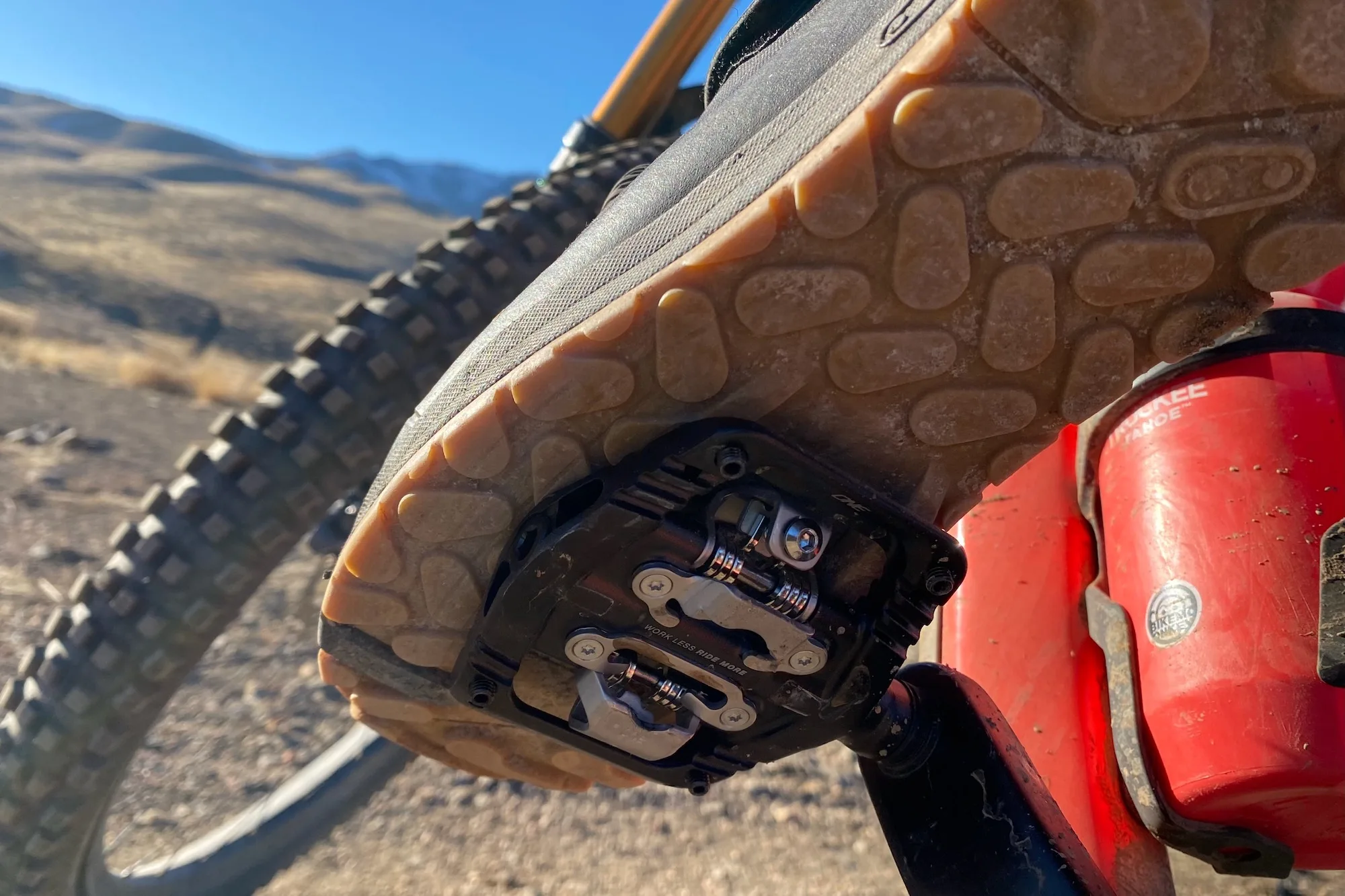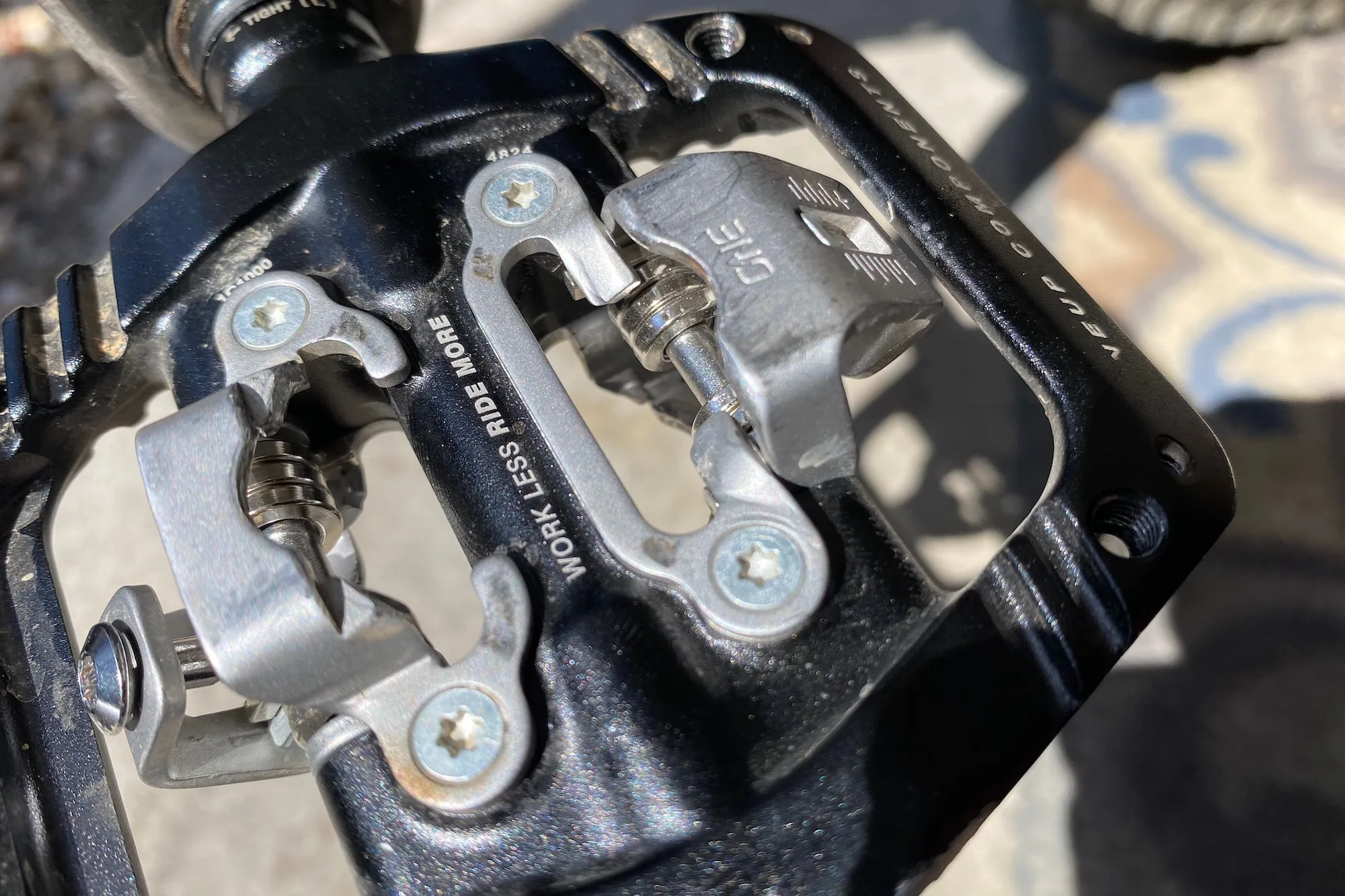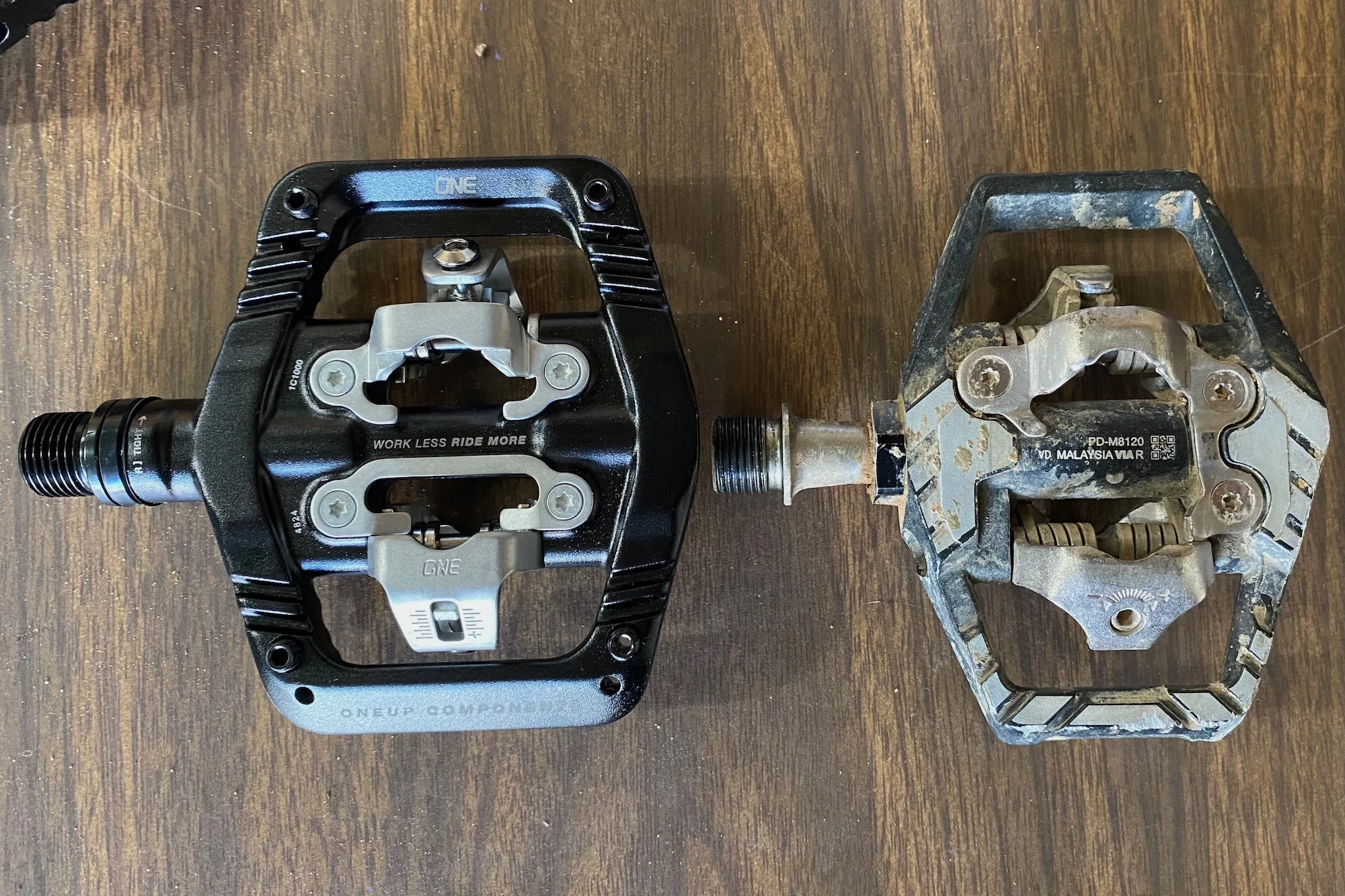OneUp Components has been on quite a roll with product launches this year. The brand most recently made waves with its unique new Wave pedals. It released an updated version of its wildly popular, and my personal favorite, V2 Carbon Handlebar. And in a move that few people saw coming, OneUp launched its new Clip Pedals back in January.
As an unapologetic OneUp fanboy, I was super excited about the new Clip Pedals. On paper, these new pedals appeared to address many of the shortcomings of other brands’ trail and all-mountain-oriented models. And as someone who has tried nearly every mountain bike pedal currently on the market, I was eager to see how they compared to similar models from the major players.
My test pair arrived just a few days after the official launch. I eagerly unboxed them, installed them on my bike, and got to testing.
- MSRP: $160
- Weight: Pair, incl. pins: 410 g, cleats: 50 g
- Style: Large platform, trail, gravity
- Cleat: OneUp, SPD compatible
- Float: 5-degrees, 12-degree release angle
- Platform Dimensions: 80 mm W x 90 mm L
- Thickness: Body: 14.4 mm, total incl. binding: 26.8 mm
- Pins: 4 per side
Pros
- Great foot support and stability
- Thin profile
- Removable pins to customize grip
- Respectably light for size
- Lots of color options
Cons
- Initial issues unclipping – now fixed
- Moderately expensive

OneUp Clip Pedals Details
Before I get into my experience riding with the Clip Pedals, let’s revisit the details and specs for those who may have missed Ron’s launch article.
Essentially, OneUp set out to design a pedal that provides “the confidence-inspiring feel of flat pedals with the efficiency and performance of clips.” That meant creating not just a large platform around the binding, but one that made significant contact with the sole to provide more support than competitors. Grip and support can also be fine-tuned through four removable hollow pins per side.
Despite having a “DH-sized” 80 mm W x 90 mm L platform, the Clip pedals are one of the thinnest on the market, with a pedal body thickness of just 14.4 mm. Including the binding, they measure 26.8 mm thick. For comparison, the HT T2 measures 17 mm, the XT Trail comes in at 18 mm, and the Shimano Saint at 19 mm (pedal body thickness). Including the binding, all of those pedals are over 30 mm thick.

OneUp developed its own stainless steel binding mechanism based around the SPD cleat. The pedals come with a set of OneUp cleats, which look identical to standard Shimano SH51 cleats, along with 1 mm cleat spacers for tuning. According to OneUp, they chose the “SPD system because it’s proven, reliable, and the world’s most popular cleat standard.” OneUp’s binding mechanism offers 5 degrees of float with a 12-degree release angle.
The Clip Pedals have DH-rated spindles to go along with their DH-sized platform. At the same time, their 410 gram weight (pedals only with pins) is much lighter than most pedals with comparably sized platforms. In fact, they weigh ~20 g less than the Shimano XT Trail and ~128 g less than the Shimano Saint.

Testing: A Rocky Start
I started riding with the Cip Pedals in mid-January, just after they were launched. I installed them on my regular trail bike and began riding the snow-free trails near my home in Reno, NV. Given that the pedals are SPD-compatible, I saved myself some setup time and went for my first test ride with some used SPD cleats on my shoes.
At the house, my initial impressions were great. Clipping in and out was crisp and well-defined, and I had no issues with either pedal while dialing in the release tension to my liking. Even with all four pins installed, entry and release seemed super clean and consistent.
Mashing up the road to my nearby trails, the platform’s sole contact and support were immediately apparent. In terms of the shoe-to-pedal connection, it blew the doors off most mid-sized trail pedals and felt nearly identical to the Shimano Saint, which is one of the most supportive pedals out there.
I ticked off some miles, and everything seemed to be just fine. Later in my ride, I noticed that clipping out of the left pedal started to feel less consistent. Sometimes it was easy and smooth, and other times it was slightly more difficult. I figured maybe they just needed to break in a bit. In the middle of that ride, I had a relatively innocuous crash, washing out in a loose corner, but somehow dislocated a finger in the process. I popped it back in on the trail, and I don’t think that crash was related to the pedals in any way.

Regardless, I swapped out my old Shimano cleats for the brand-new set supplied by OneUp. Initially, the fresh cleats felt extra-smooth clipping in and out. Over the course of my next few test rides, however, the inconsistency of clipping out from the left pedal came back, and came back strong. In fact, I toppled over awkwardly numerous times at a complete stop because I wasn’t able to release my foot from the pedal at all.
I’ve been clipping into mountain bike pedals for ~30 years now. I haven’t fallen over because I couldn’t unclip in probably 29 years. I could tell that something was amiss, and the cleat was clearly binding up in the mechanism somehow. The strange thing about it was that the exact same cleat and binding on the other foot functioned perfectly normally.
I tried different shoes, thinking the dimensions of the cleat box could be the problem. I switched between the Crankbrothers Mallet Trail BOA and the Specialized 2FO Cliplite, and it made no difference. I added cleat spacers to see if that would help, but it did not. No matter what combination of shoe and cleat I tried, it was the same.

Notice of a Running Change
I asked around to a handful of other media types who I knew were testing the pedals — all fine. It couldn’t just be me, could it? I looked around online and found a first look review posted on NSMB that mentioned the exact same issue I was experiencing. Then I sent a message to my contacts at Oneup and told them about the issue I was having and expressed my concerns about the pedals.
A few days later, OneUp issued a “notice of running change and product improvement.” Apparently, the guy from NSMB and I weren’t the only ones who had issues unclipping from the pedals. While many riders have not and may never have any issue, it seems that the specific combination of angles and forces at which I twist my left foot to release from the pedal caused the binding to happen.
While it is undoubtedly unfortunate that OneUp brought a pedal to market that wasn’t 100% perfect, I was impressed with how they responded. They spread the word quickly through the bike media, offering customers the option of sending their pedals in to be upgraded or to have an upgrade kit sent to them. The fix? A barely noticeable modification to the rear binding plate.
At OneUp’s request, I sent my pedals back for the upgrade. A few weeks later, I got them back and started testing again.

Testing: Take Two
After my previous experience with the OneUp pedals, I approached the updated pair with a bit of trepidation. The obvious strike against them — not being able to unclip — was hopefully resolved with the updated rear binding plates. Everything else about these pedals seemed so well-considered and dialed, I just need to wash the bad taste out of my mouth.
So, I installed the fresh OneUp cleats on my shoes, turned the release tension down lower than usual, and crossed my fingers. Like magic, the updated binding plates completely resolved the issue I was having. All it took was removing the tiniest bit of material from the leading edge of the angled-down binding plate wings.
Since then, I’ve had about three weeks of riding on the Clip Pedals. I’ve been riding them with the OneUp cleats and some pre-loved Shimano cleats, and both have been working just fine. Entry and exit have been clean, consistent, and smooth, although just a shade less buttery than Shimano. The cleat/binding interface is super tight and slop-free, and the range of release tension adjustment is more than adequate for my needs.

The shoe-to-pedal interface continues to impress me, and the level of support is fantastic. The usable platform is truly DH-sized and super stable underfoot. I played around with the pins a bit, but ultimately decided to remove them all because I don’t need any more grip or stability than the platform already provides.
It’s also pretty remarkable just how thin these pedals are. For the size of the platform, pedal strikes have been a non-issue. And for a pedal that’s comparable in platform dimensions and support to the Shimano Saint, I think the low weight is very impressive, too.
I have several hundred miles on these pedals, and they are still spinning as smoothly as they should be. I obviously haven’t needed to service them yet, but the procedure is super simple. I pulled them apart just to check out the internals, and it took about a minute. OneUp even includes the necessary thin-walled 8mm socket with the pedals.

OneUp Clip Pedals: My New Favorite
Since OneUp has addressed a significant and potentially very dangerous flaw, I think the Clip Pedals are about as close to perfect as any pedals on the market. The SPD-compatible binding mechanism offers consistent entry and release and a secure hold. The generous and well-designed platform provides class-leading support and stability with the thinnest profile on the market. Combine all that with a very reasonable weight, and these are my new go-to for any ride that doesn’t include a cross-country bike.
Now that my left foot isn’t stuck in the pedal, I can confidently recommend the OneUp Clip Pedals to just about everyone. I think they are a particularly compelling new option that should suit everything from trail bikes to full-on DH rigs. If you’ve been dissatisfied with the support provided by the so-called “platforms” of similar clip pedals, then these are worth a serious look.

